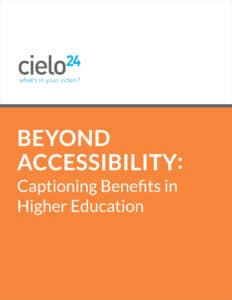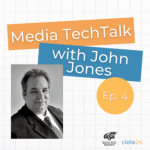Transcript - Episode 004 Nicole Flynn, is joined by John Jones, Director of Media Resources…

Resources & Tips for Rolling Out an Accessible Transcription Program
In our latest episode of Media TechTalk, Nicole Flynn speaks with the education innovator whose advocacy for accessible instructional design has allowed students with a broad range of disabilities to foster at Wichita State University. John Jones is the current Director of Media Resources Center, as well as the interim accessibility coordinator, at Wichita State University, and handles the intersection between technology and instruction, including rolling out an accessible transcription program.
In today’s academic climate, the smooth integration of technology and instruction is not just helpful, but necessary. Wichita State University is no stranger to accessible instruction. Like many educational institutions, their push for accessible education sparked from a complaint from a disabled student. Since then, Wichita State has spent the past four years developing better accessibility practices for both their in-person and online courses.
John says, “For us, I got involved because just as a personal value, I could see that all of the teams that I ran in the Media Resources Center were teams that really needed to exhibit a certain amount of leadership if we were gonna achieve accessibility.”
Captioning and Transcription Programs as Accessibility Tools
One of the accessibility tools they began investing in is captioning. All the teams could use captioning. Whether they were the video, web, or classroom technology team, they needed to be thinking about what it means to be accessible in classrooms of all forms. John reflects on their movement to caption thinking, “Everybody needed to be getting on board with this, and we could wait for somebody else to try and give us a mandate or we could just get going, and we just got going.”
This outlook on accessibility practices focuses on more than just meeting state requirements. Wichita’s focus on parity puts them in a position to think differently about accessibility and accommodations. Rather than thinking, “What’s the least amount of video that we can caption or amount of materials we can get away with Brailing,” John pushes his team to think about how they can help disabled students reach the same objectives and get the same resources and interactions.
Allocating Funding and Resources For Accessibility
COVID-19 has transformed University and school district budgets dramatically. As schools moved online, many in-person expenses have been mitigated, freeing up funding and resources for online accessibility. In Wichita’s case, they were able to subscribe to cielo24 at a level that would allow them to caption all instructional videos. While there are still some unknowns about how many captioning minutes are needed and logistical questions, captioning can simplify your accessibility practices and take the burden of captioning off of faculty’s plates.
With additional funding in the organization’s budgets, it’s even more important for leaders in accessibility and accommodation front to communicate the needs of disabled students and opportunities to fund products that will make your educational experience equal for all students. This extends beyond captioning. Textbook accessibility, physical accessibility on campuses, text size standards for Powerpoints, and student-generated content are all avenues that organizations should look into for better accessibility practices.

Training is Key
Rolling out a comprehensive captioning and transcription program doesn’t have to fall on just one team. Training instructors, students, or other faculty members on how to make their content accessible can be quick and easy. In Witchita’s case, they utilized Acclaim to assign 20 to 30-minute training sessions that deliver a badge upon completion. Students can learn Microsoft Word accessibility, general web accessibility, or presentation accessibility, among many other topics. Organizations that seem to have incredible accessibility practices have these centralized resources that allow them to be successful.
Additional Resources for Rolling Out a Transcription Program:
Kansas Accessibility Resources Network
2020-2021 State & Federal Accessibility Guidelines Ebook
WCAG 2.1 for Video Accessibility Ebook
Accessibility Budget Resources
cielo24 provides solutions for higher education captioning programs
cielo24 can help with all your inclusive technology and video captioning needs. Captioned videos aid in managing all your educational video content. We provide everything from searchable captions™, transcripts, and accessibility compliance powered through video intelligence. Our inclusive technology will improve student learning results and transform unstructured content into an organized, searchable video library. To get started visit us online or call us at 1-855-243-5624.



